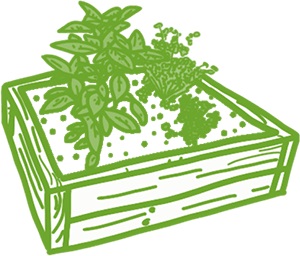
Planters, pots and raised beds can be good for strong-growing plants like mint and lemon balm that can spread and take over in the rest of the garden.
A general rule is to choose a ‘filler, thriller and spiller’; plants which will fill the planter, others that offer some ‘wow’ and others that will tumble over the sides.
Tools and kit needed
- gloves
- trowel or spade and fork
- peat-free compost
- mulch
- watering can/hose
- water point
- suitable containers/pots for planting in
- porous lining for pots e.g. newspaper
- plants!
Preparation and planting
Choose a multipurpose peat-free potting compost. For plants that require good drainage, add a bit of grit and sharp sand to the mix.
Choose containers that are big enough to hold all the plants with room around their root balls - generally, allow around 2-4 inches for growth.
For existing planters, pots or raised beds:
- Check the condition of planters and repair any damaged sections
- Clear any weeds, tree seedlings and ivy, etc, including roots
- If re-using pots, clean with a soft brush or wash with warm water
- Rejuvenate soil - add compost and dig in
For new planters, pots or raised beds
- Make sure there is adequate drainage. The holes don’t need to be large, but there must be enough so excess water can drain out. Drill extra holes if necessary. (Add a porous lining such as newspaper to stop compost escaping, if needed.)
- Fill compost to a level that will lift the root ball of the plant so that its top sits just below the lip of the container, leaving room for watering.
- Remove the plant from its existing pot and gently tease out any roots that have started circling.
- Place the root ball in the planting hole and fill with soil/compost, watering as you fill.
- Tamp the soil gently; you don’t want to compact the soil, just put it in contact with the roots.
Caring for planters, pots and raised beds
Monitor plants in raised beds, pots and planters as they can suffer more quickly and severely from drought. Water regularly in dry weather and consider mulching with wood chip or similar to reduce water loss, (make sure you keep the mulch away from plant stems - leave about an inch or so clear). To reduce the need for watering, choose drought tolerant plants.
Choosing plants
Consider using perennials; these flower reliably every year, usually growing in size each time and should last a few years in a container, after which time they can be planted in the garden. Look at underplanting with spring bulbs such as daffodils, to provide year-round colour.
- Scented/Upright plants: Rosemary - Rosmarinus officinalis ‘Miss Jessops Upright’; Salvia -Salvia officinalis ‘Icterina’; Persicaria - Persicaria microcephala ‘Red Dragon’; Lavender - Lavandula angustifolia. Mid Height: Lady’s mantle - Alchemilla mollis; Geranium endressii; Anemone blanda var. rosea; Elephant’s ears - Bergenia cordifolia; Blue lilyturf - Liriope muscari; Hellebore; Geum ‘Lady Stratheden’; Penstimon; Heuchera; Lambs Ear - Stachys Lanata.
- Decorative grasses: Festuca glauca; Black lily turf - Ophiopogon planiscapus ‘Nigrescens’; Japanese Sedge - Carex oshimensis ‘Evergold’
- Small shrubs: Fuchsia - Fuchsia ‘Empress of Prussia’; Hebe - ‘Red Edge’.